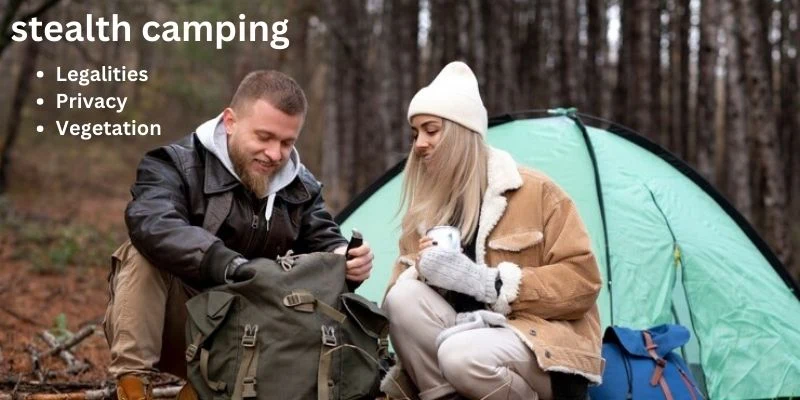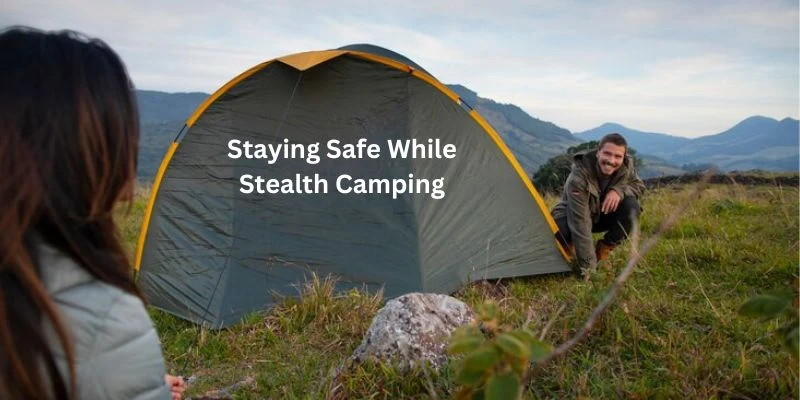Unveiling the Mystery: What is Stealth Camping? Discover the 15 Secrets
Updated: 5 Aug 2024
261
Stealth camping is like camping without a permit. It means finding a place to sleep outside that isn’t a campground. People do it because it’s exciting and they want to be close to nature. It’s like a secret adventure!
This comprehensive guide will explore the ins and outs of this discreet way of camping. Whether you’re an eco-friendly camper or an adventurous soul craving an undisturbed night under the stars, stealth camping might be your next escapade in nature.
What is Stealth Camping?
Stealth camping involves setting up a campsite in a location where camping is not permitted, such as outside of designated campgrounds or on private property. Stealth campers aim to conceal their presence, often arriving late at night and departing early in the morning to avoid detection.

The Ethics of Stealth Camping
| Stealth Camping Protocols |
|---|
|
Selecting the Perfect Stealth Camping Spot
Finding the perfect spot for stealth camping takes careful planning. You need to think about staying safe, having privacy, and protecting the environment.
1. Legalities:
Ensure that stealth camping is legal in the area you plan to camp. Some regions may have strict regulations or prohibit camping outside designated campsites.
2. Privacy:
Look for secluded areas away from popular trails, roads, and recreational areas to minimize the chance of being discovered.
3. Terrain:
Choose a flat, level spot for your tent to ensure comfort and stability. Avoid areas prone to flooding or rockslides.
4. Vegetation:
Select a spot with dense vegetation, such as bushes or trees, to provide natural camouflage and concealment.
5. Distance from Water Sources:
Camp at least 200 feet away from any water source to prevent contamination and minimize the risk of encountering wildlife.
6. Safety:
Assess potential risks such as falling branches, flash floods, or wildlife activity before setting up camp. Avoid areas with signs of recent animal activity or potential hazards.
7. Accessibility:
Consider how easily you can access the spot, especially if you need to carry heavy gear. Stay away from places that need a long or risky hike to get to. You may discover 5 unforgettable best camping destinations for your next adventure.
8. Leave No Trace Principles:
Choose a spot where you can minimize your environmental impact. Practice Leave No Trace principles by avoiding fragile ecosystems and packing out all trash.
9. Weather Considerations:
Check weather forecasts before choosing a spot, and select an area protected from strong winds, heavy rain, or extreme temperatures.
10. Distance from Civilization:
Camp far enough away from roads, towns, or other inhabited areas to avoid unwanted attention or disturbances. Camping in United States is also a good option for you.
11. Light Pollution:
Avoid areas with significant light pollution, especially if you want to enjoy stargazing. For beginner campers, you must visit Camping World in Bartow, Florida, and also enjoy Car Camping in Florida.
12. Exit Strategy:
Plan an exit strategy in case you need to leave quickly or unexpectedly. Be aware of your surroundings and potential escape routes.
13. Local Wildlife:
Research the local wildlife and their habits to avoid disturbing or encountering potentially dangerous animals.
14. Respect Private Property:
Avoid camping on private property without permission. If unsure, research property boundaries or ask for permission from the landowner.
15. Minimal Impact:
Leave the campsite as you found it, or better. Minimize your impact on the environment by avoiding unnecessary disturbances and disturbances. You have a chance to visit Camping World in Lake City, Florida. You can find things there to make your camping trips more fun and comfortable.
By considering these factors, you can select a stealth camping spot that offers safety, privacy, and minimal impact on the environment while ensuring an enjoyable outdoor experience.
Gear Essentials for Stealth Camping
| Gear Item | Description |
|---|---|
| Small, low-profile tent | The headlamp is equipped with a red light setting to maintain night vision without drawing attention to your location. |
| Hammock | Lightweight hammock with a muted color scheme for stealth camping. if you are Truck Camping in Alaska then also keep this because it is very useful. |
| Sleeping bag | Choose a sleeping bag appropriate for the season to ensure comfort and warmth. |
| Portable stove | If cooking is essential and permitted, opt for a compact and lightweight portable stove. |
| Headlamp with red light setting | Headlamp with a red light setting |
Staying Safe While Stealth Camping
Staying safe is really important when you’re camping in the wild. It’s important to tell someone where you’re going and when you’ll be back. Be mindful of potential encounters with wildlife by keeping food secured and your campsite clean. If you’re planning a summer camp in Nice, France, safety is also very important. Make sure to learn about safety rules and what to do to stay safe. It’s also a good idea to have a plan for keeping yourself safe, especially if you’re going to be alone.
Safety Points about Stealth Camp:
There are a few things to keep in mind when stealth camp:
1. Laws and regulations
It is important to be aware of the laws and regulations in the area where you are planning to camp. Stealth camping is illegal in many places, and you could be fined or even arrested if you are caught.
2. Safe location
It is important to choose a best location that is safe and secluded. Avoid camping in areas that are heavily trafficked by people or wildlife.
3. No trace behind
It is important to leave no trace behind. This means packing out all of your trash and disposing of it properly.
4. Be Ready
It is important to be prepared for the unexpected. So, you need a plan for what to do if a park ranger or someone who owns the land finds you.

Difference Between Stealth Van Camping and Stealth Truck Camper
| Aspect | Stealth Van Camping | Stealth Truck Camper |
|---|---|---|
| Vehicle Type | Utilizes a van (e.g., minivan, cargo van, camper van). | It is harder to blend in due to its larger size and distinct appearance. |
| Size and Mobility | Smaller and more maneuverable; better in urban areas and narrow roads. | Larger and less maneuverable, especially with a full-size truck. |
| Camouflage | Can be modified to appear inconspicuous, blending into urban/rural settings. | More interior space allows for additional amenities and comfort. |
| Interior Space | Limited space; requires efficient use for sleeping and storage. | More interior space; allows for additional amenities and comfort. |
| Setup and Conversion | Customizable interiors with sleeping platforms, storage solutions, and other amenities. | Often pre-built with features like beds, kitchens, and bathrooms, requiring less setup time. |
| Parking and Stealth | It attracts more attention due to its larger size, especially in urban environments. | Some are equipped with off-road capabilities for remote or rugged terrain camping. |
| Off-Road Capability | Generally, better fuel efficiency, especially smaller vans or those with efficient engines. | Better off-road capability, especially with 4×4 trucks, for accessing remote camping spots. |
| Fuel Efficiency | Generally, there is better fuel efficiency, especially smaller vans or those with efficient engines. | Lower fuel efficiency, particularly when carrying the extra weight of a camper. |
| Cost | Relatively affordable, especially if purchased used; potential for DIY conversions. | Typically more expensive; cost varies depending on size, features, and brand. |
What Is The Best Vehicle For Stealth Camping
When picking a car for stealth camping, think about how big it is, how well it hides, and how comfy it is. A van is often a good choice because it has lots of room for sleeping and stuff, and you can make it feel like home. Look for a car with dark windows and a plain look to blend in with cities. A big SUV or a car with seats you can take out might work, too, if you like to move around a lot. The most important thing is to find a car that’s comfy for camping but doesn’t stand out and follows the rules.
Experienced Wisdom for Beginner Stealth Campers
- Research your destination thoroughly before setting up camp
- Learn about local wildlife habits to stay safe and respectful
- Start by camping close to home to build confidence and experience
- Read stories and advice from seasoned stealth campers
- Join online forums or communities for insider tips and moral support
Difference between Stealth Camping and Traditional Camping
| Aspect | Stealth Camping | Traditional Camping |
|---|---|---|
| Location | Small, low-profile tents or hammocks that blend into surroundings. | Designated campsites with facilities and amenities. |
| Visibility | Focus on staying inconspicuous and minimizing visibility. | Open, designated areas where campers are visible to others. |
| Setup | Small, low-profile tents or hammocks. | Larger tents or structures with amenities like tables and chairs. |
| Legalities | Small, low-profile tents or hammocks that blend into the surroundings. | Permitted and regulated by authorities in designated campsites. |
| Access to Amenities | Often lacks bathrooms, potable water, or trash disposal. | Access to bathrooms, potable water, and waste disposal facilities. |
| Experience & Challenges | Solitary, rugged experience requiring self-sufficiency and navigation skills. | Structured camping with facilities and organized activities. |
| Environmental Impact | Mindful of minimizing environmental impact and leaving no trace. | Follow campground rules to minimize environmental impact. |
| Equipment & Gear | Lightweight, compact gear for mobility and concealment. | Larger, more comfortable gear with less concern for space and weight. |
The Future of Stealth Camping
More and more people want to enjoy the outdoors without spending a lot of money. So, stealth camping is becoming more popular. This trend presents a dialogue about land use, conservation, and how we approach responsible recreation. For the future of both stealth camping and traditional campsites, this practice must stay sustainable and eco-friendly.
Pros and Cons of Stealth Camping
| Pors |
|---|
|
| Cons |
|---|
|
Conclusion
If you’re thinking about stealth camping, you should think carefully about it first. There are good and bad things about camping in places where it’s not allowed. With careful planning and preparation, stealth camping can be a great way to experience the outdoors on a budget. However, it is important to be aware of the laws and regulations in the area where you are planning to camp and to take steps to minimize your impact on the environment.
FAQs
Is stealth camping legal?
The laws about stealth camping are different in different places. It’s crucial to research the rules and regulations specific to your desired location before embarking on a stealth camping trip.
Can I have a campfire while stealth camping?
No, it’s usually not allowed to have a campfire while stealth camping. This helps reduce the risk of detection and prevents accidental fires.
Is it safe for solo travelers to go stealth camping?
Solo travelers should take precautions like informing someone of their plans and having a safety plan. It’s best to start with shorter trips and gain experience before tackling longer or more remote stealth camping adventures.
Is it necessary to obtain permission from the landowner before stealth camping on private property?
Yes, you must get permission from the landowner before stealth camping on private property.
Can I use my regular camping gear for stealth camping?
You can use some regular camping gear, but choose lightweight and compact items.
How can I become a more responsible stealth camper?
Follow Leave No Trace principles: dispose of waste properly, avoid damaging vegetation, and minimize noise. Camp only in designated areas or on durable surfaces to reduce your impact.
Please Write Your Comments